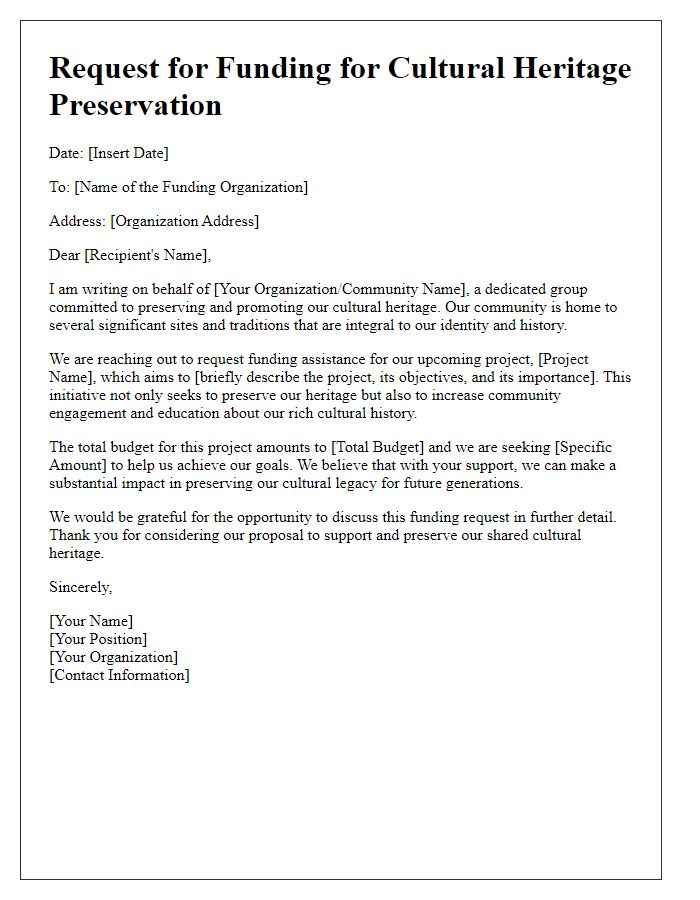Cultural heritage is the heart and soul of communities, reflecting shared histories and traditions that connect us to our past. In today's world, where rapid development often threatens these treasures, it's essential to recognize the importance of preservation. By protecting our cultural heritage, we not only honor our ancestors but also enrich future generations with stories and legacies that shape their identities. Join me in exploring how we can safeguard these invaluable treasures in the following sections!

Cultural Significance and Historical Context
Cultural heritage protection embodies the safeguarding of sites, artifacts, and traditions that hold significant cultural value, such as the Great Wall of China or the Pyramids of Giza, both testaments to ancient civilizations. These landmarks reflect the architectural ingenuity and historical narratives of their respective cultures. The preservation efforts often involve local communities, who understand the intrinsic value of their heritage, and international organizations like UNESCO, which identifies World Heritage Sites that deserve special attention. Historical context is crucial; for instance, the colonial histories affecting indigenous sites in Australia or the impact of the Industrial Revolution on urban structures in Europe highlight the ongoing dialogue between past and present. Cultural significance also extends to unmarked graves or memorials that honor historical events, such as the 9/11 Memorial in New York City, fostering a collective memory essential for cultural identity.
Legal and Regulatory Frameworks
Cultural heritage conservation relies heavily on robust legal and regulatory frameworks, which establish guidelines and standards for protecting sites of historical importance, such as UNESCO World Heritage Sites. The 1972 UNESCO World Heritage Convention promotes global cooperation and provides mechanisms for recognizing and safeguarding cultural landmarks. National laws, like the National Historic Preservation Act (NHPA) in the United States, ensure the protection of archaeological sites and architectural treasures. Local ordinances often supplement these regulations, addressing specific community needs and promoting cultural identity. Agencies, such as the National Park Service, oversee compliance with heritage conservation laws and facilitate public involvement in preservation efforts, enhancing community engagement and awareness of cultural significance.
Community Engagement and Support
Cultural heritage protection involves active community engagement and support initiatives aimed at preserving tangible and intangible assets significant to a community's identity. Local organizations, such as historical societies or cultural preservation foundations, play a pivotal role in educating residents about the importance of sites, traditions, and artifacts. Events like heritage festivals, educational workshops, and community meetings foster participation and raise awareness. Legislation, such as the National Historic Preservation Act, encourages collaboration between government entities and communities to secure funding and resources for preservation projects. In cities like Athens, Greece, or Kyoto, Japan, strong community involvement has proven essential in safeguarding ancient structures and practices against modernization pressures. Engaging local stakeholders ensures that cultural narratives are maintained while simultaneously enhancing social cohesion and local pride.
Preservation Strategies and Techniques
Cultural heritage protection encompasses various preservation strategies and techniques that aim to safeguard significant sites, artifacts, and traditions. Techniques include conservation methods for ancient structures, such as the meticulous restoration of the Parthenon in Athens, Greece, a 5th-century BCE temple symbolizing Classical architecture. Conservation scientists employ scientific analysis to understand material degradation, utilizing advanced imaging technologies to document historical murals and frescoes within sites like Pompeii, Italy, which suffered from volcanic ash in 79 CE. Community engagement initiatives in places like Kyoto, Japan, encourage local participation in preserving traditional crafts and rituals, ensuring cultural transmission across generations. Legislation such as the UNESCO World Heritage Convention, established in 1972, plays a crucial role in promoting international cooperation for heritage conservation, recognizing the universal value of cultural diversity throughout every continent. Sustainable tourism practices, as seen in Machu Picchu, Peru, help manage visitor impact while promoting preservation through responsible heritage management in ecologically sensitive areas.
Funding and Resource Allocation
Cultural heritage sites, such as the ancient Roman Colosseum in Italy or the historic city of Petra in Jordan, require significant funding and resource allocation to ensure their preservation and protection. This financial support is crucial for maintaining structural integrity and combating environmental threats. In 2022, UNESCO identified over 1,000 World Heritage Sites at risk, highlighting the urgent need for fiscal assistance. Investments in skilled conservationists and advanced technology, including drones for surveillance or 3D scanning for restoration, can enhance protective measures. Furthermore, community engagement initiatives can foster public awareness and support, ensuring sustainable management of heritage resources across diverse regions and cultures.
Letter Template For Cultural Heritage Protection Samples
Letter template of partnership proposal for cultural heritage initiatives

Letter template of notification for cultural heritage event participation












Comments